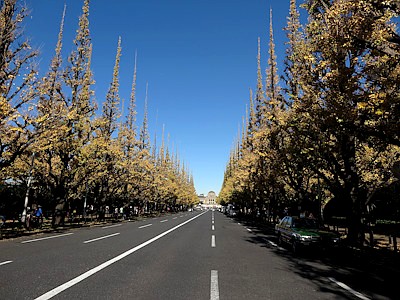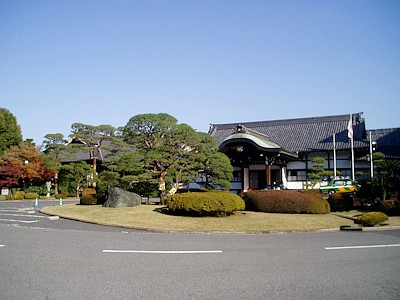Meiji Jingu Shrine
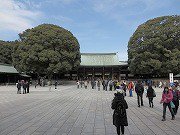 Meiji Jingu (明治神宮), often called Meiji Shrine in English, is one of the most notable and highest-ranking Shinto shrines in Japan.
Meiji Jingu (明治神宮), often called Meiji Shrine in English, is one of the most notable and highest-ranking Shinto shrines in Japan.
Located adjacent to JR Yamanote Line Harajuku Station, this huge Shinto shrine was established in 1920 to honor Emperor Meiji (1852-1912) and his wife Empress Shoken (1849-1914). If you are going to visit Tokyo for sightseeing, this spot is must-visit.
It's open from sunrise to sunset every day and is admission free.



Outline
This shrine, founded in 1920, was a new type of shrine at the time of its foundation in that it was built as a national memorial.
Meiji is the posthumous name of Emperor Mutsuhito (1852-1912) and the period of his reign (1868-1912) as well in Japanese traditional calendar. The term Jingu was before WWII a special name allowed by the emperor only to the highest-ranking shrines enshrining emperors or their ancestral gods (except for a few historically special shrines given this title).
When the Meiji Restoration which toppled the Tokugawa Shogunate took place in the late 19th century ending the feudal times, Japan's indigenous religion Shintoism, which played an important role in this movement, was divided into two parts: Sect Shinto, the Shintoism as religion which belonged to the private sector, and State Shinto, the Shintoism which belonged to the state and assumed part of its ceremonial role and thus was declared not - at least nominally - a religion. Here traditional Shinto shrines were determined to belong to the latter and be treated as public facilities. And it was in this context that Meiji Shrine was established - to commemorate the deceased emperor who embodied the rise of modern Japan.
When the emperor passed away, local politicians and other influential figures of Tokyo petitioned to construct his grave in Tokyo, but it turned out to be impossible because it was the will of the emperor himself that his tomb was to be situated in Kyoto, the city where he had been born and brought up when young. So they changed their strategy to create a monument instead in Tokyo, which eventually led to the creation of this facility.
The shrine was erected for Emperor Meiji not only because he was a monarch but also thought to be a great one, so his successor Taisho (1879-1926), who was rumored to have developed mental illness during his reign and couldn't assume his role properly, has never been enshrined in a shrine after his death to this day (except in a special shrine located in the Imperial Palace which enshrines every one of the Japanese emperors in history). As for Emperor Showa (Hirohito, 1901-1989), there's a memorial hall dedicated to him on the outskirts of Tokyo but I doubt ordinary Japanese people even know its existence, and its only a small modern building owing to the separation of religion and state executed after WWII which made it no longer possible for the government to establish a new Shinto shrine.
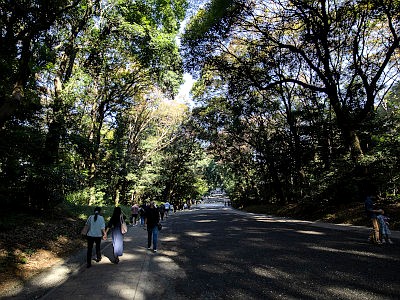

The Meiji Jingu Museum, designed by Kuma Kengo, was costructed in 2019.

Large Shinto shrines are often presented sake barrels from sake manufacturers. Sake, which is a kind of Japanese domestic alcohol beverage, is used in Shinto rituals.

These wine barrels were presented from wine producers of Bourgogne, France. Meiji Emperor is said to have loved wine.
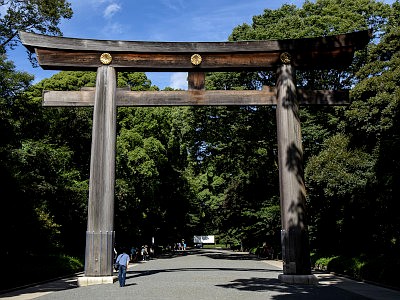
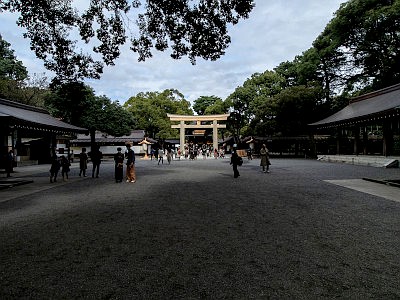

Core architecture
Most of its original core buildings were burned down in WWII and were reconstructed after the war, though in a little different design.
If you go into the courtyard from one of the gates surrounding the yard, at the northern end stands the Outer Haiden, the building where ordinary people offer prayers. The next building which you can see from there in the recess is the Inner Haiden, the place where priests offer prayers.
Behind the Inner Haiden stands the Honden, the very building where the divinities are enshrined, but at this shrine you cannot see the Honden from the ground. You can check the structure of these buildings including Honden on the aerial imagery provided through Google Maps. The Honden is the building where the marker is placed.
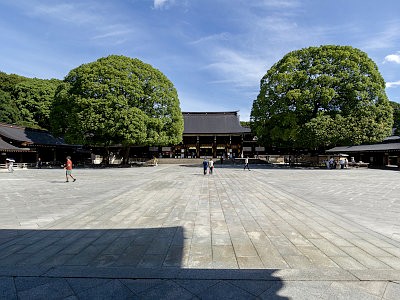
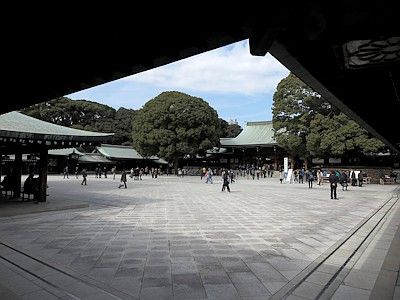

Outer Haiden is the building in front of which ordinary people offer prayers.

The Inner Haiden, the builiding in the recess of the Outer Haiden, is the where priests offer prayers. The Honden, the very building where the divinities are enshrined, is behind this building, though you cannot see it. It is not allowed to take photos of the Inner Haiden now.

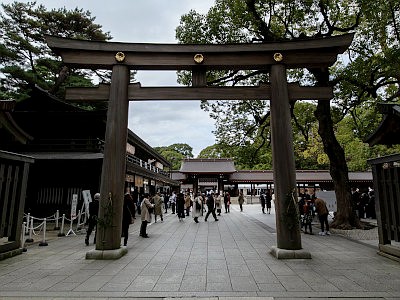
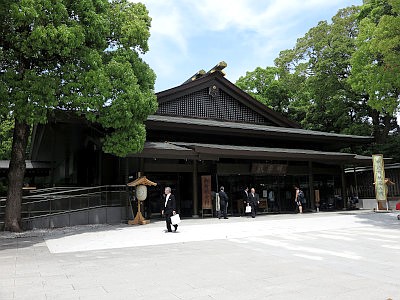
Forest
The solemn and vast forest now covering its grounds was artificially created for the shrine on the wasteland based on modern science, in accordance with the Japanese traditional notion of what the sacred residence of gods should look like. On creating this forest, there was a debate over whether to make a Japanese cedar forest or one similar to the natural forests which existed around modern-day Tokyo before the urbanization, and the latter was selected considering the air pollution and soil. Top scientists who mastered German forestry took charge of the planning, and factoring in various elements, it was planned so that on the fourth and final stage of the forest (after a hundred and several decades to two hundred years from those days) there should emerge a forest resembling a domestic natural forest and remain so eternally - though at present its transition is ongoing faster than expected.
Before the creation of the shrine, there used to be 15,000 trees in the whole 700,000-square-meter (175-acre) land, but the number reached 120,000 when completed.

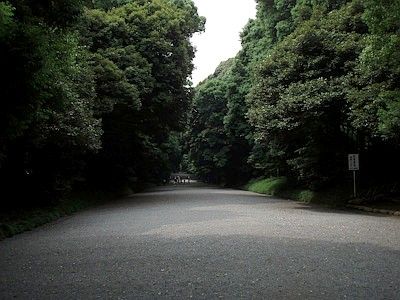

This two photos show what happened to the land before and after the creation of Meiji Shrine. The railroad in the middle is the JR Yamanote Line. It is a view from the east side (Harajuku side), and looking toward south. This is a page from a book named "大都会につくられた森 明治神宮の森に学ぶ" published in 1992.
Inner garden
Although most of its grounds used to be a wasteland before the foundation of the shrine, the area presently being the Inner Garden was different - it used to be a suburban house of a domain lord in the feudal times. In the following Meiji era the emperor created an iris garden here for the empress, and when the shrine was constructed, this place was merged into it as the Inner Garden.
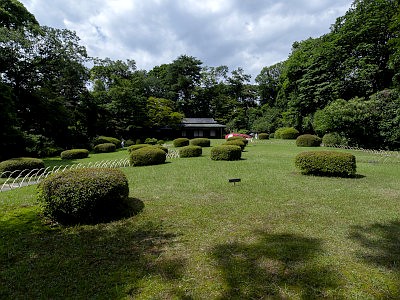
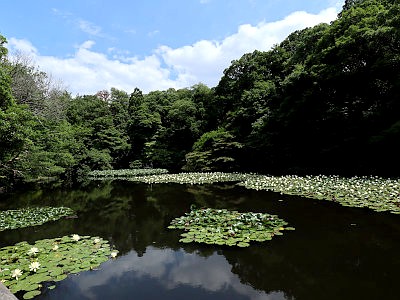

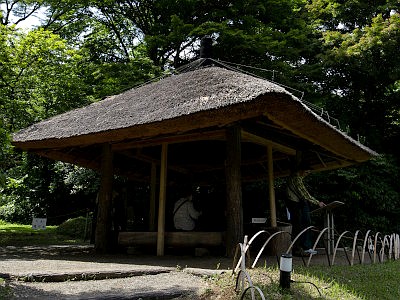
Homotsuden
Homotsuden, the museum built to exhibit the belongings of Emperor Meiji, was completed in 1921 in a traditional style but with reinforced concrete. It is a pretty early example of traditional-style constructions built in this new material which were mainly used for military facilities in those days. Thus being designated as an Important Cultural Property.
Ever since the Meiji Jingu Museum was newly built in 2019, this older museum is closed usually, but occasionally it is disclosed.
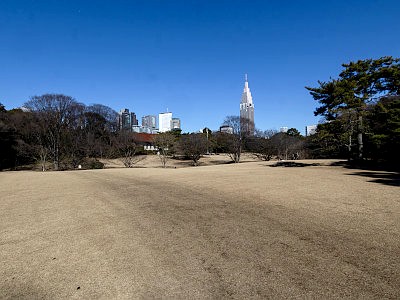

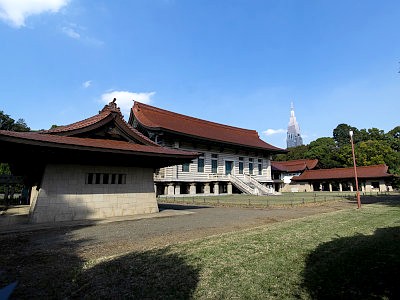
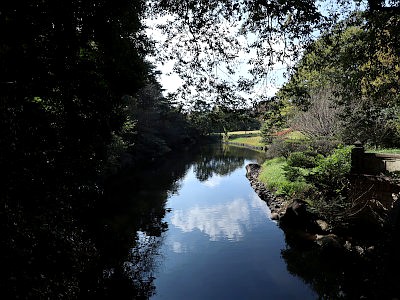
Notable Events
Of the many annual events held at Meiji Jingu, below are especially noteworthy.
- New year: Hatsumoude
Hatsumoude is a countrywide custom of visiting Shinto shrines in early January. Meiji Shrine attracts visitors the most in Japan. - Late April to early March: Spring Grand Festival
Beside formal ceremonies, traditional music and dance are offered. - Late October to November 3: Autumn Grand Festival
This is the most important festival for this shrine. In addition to what was performed in the Spring Grand Festival, on November 3, the envoy from the emperor is dispatched to the shrine to dedicate offerings. Various martial arts are also on public display on this day, including yabusame (shooting arrows from running horseback).
Hatsumode
Hatsumoude is a countrywide custom of visiting Shinto shrines (and some major Buddhist temples) to offer prayers in the early days of a new year, first three days in particular. And of all the shrines and temples in Japan, Meiji Shrine attracts prayer-offerers the most - it's estimated that over three million people visit this shrine during the first three days of January. For details, see the article on hatsumode at Meiji Shrine.


Momote-shiki
On the 2nd Monday of January, which is a national holiday called Coming of Age Day, a traditional archery ritual called the Momote-shiki is practiced.

Kigen-sai
On National Foundation Day, a national holiday fixed to February 11, a large parade consisting of marching bands and mikoshi is conducted. For details about this event, see the article on the Kigen-sai at Meiji Jingu.

Haru no Taisai
The grand festival of Meiji Jingu is held in spring and fall. Haru no Taisai, or the Spring Grand Festival, is held from May 2 to 3. For details about this event, see the article on the Haru no Taisai at Meiji Jingu.

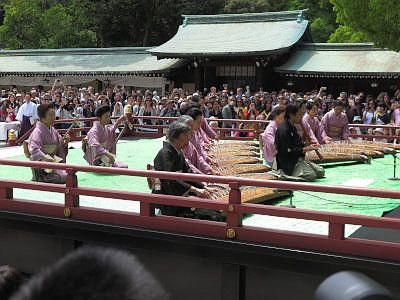
Harajuku Super Yosakoi
The Harajuku Super Yosakoi, held aroud JR Yamanote Line Harajuku Station in late August, is a large yosakoi street dance festival dedicated to Meiji Jingu. For details about this event, see the article on the Harajuku Super Yosakoi.
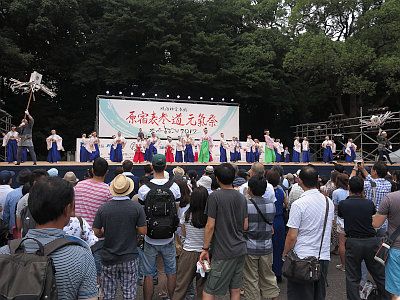
Aki no Taisai
The grand festival of Meiji Jingu is held in spring and fall, but the one held in fall is larger and more important. The Aki no Taisai, or the Autumn Grand Festival, is held mainly from November 1 to 3. For details about this event, see the article on the Aki no Taisai at Meiji Jingu Shrine.
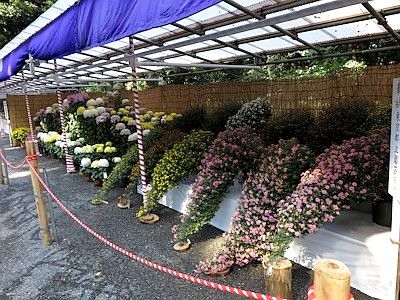

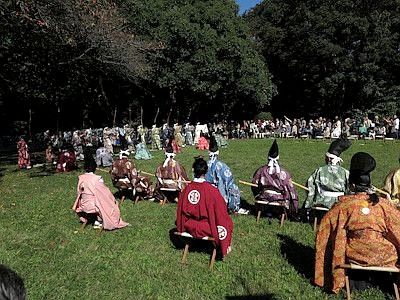
Niinamesai
On November 23, which is a natinal holiday named Labor Thanksgiving Day, a ceremony called the Niinamesai is held. Here, around ten treasure ships composed of vegetables will be exhibited. For details about this event, see the article on the Aki no Taisai at Meiji Jingu Shrine

Jingu Gaien and Meiji Kinenkan
JapaneseThe Gaien, or the outer precincts of Meiji Shrine, which lies about 1km (0.6mi) to the east of the inner precincts (the Naien) where the shrine's main buildings stand, consists of several sports facilities like baseball stadiums and Meiji Memorial Picture Gallery, a large painting gallery of the emperor. The Gaien was intended to be a modern, Western (the global standard style among the world powers of the time), non-religious and entertaining park, being in sharp contrast to the traditional, domestic, sacred and solemn Naien. This was to represent by these two precincts the characteristics of the era which was reigned by an emperor of an ancient lineage (the descendant of the first emperor Jinmu, grandson of Sun goddess Amaterasu, who founded Japan in 660 BCE according to history books written in the eighth century) with modern technology and social system. (By the way, academically the authenticity of Japan's imperial family tree prior to the sixth century is pretty murky because there were no writing system in Japan in those days and history had been passed on verbally in the court by professional narrators. So when Japan's "actual history" emerged from the mist, the present imperial family and their dynasty was already there from long ago, and remains there ever since.)
The Meiji Kinenkan (Meiji Memorial Hall, 明治記念館) next to the Gaien, now used as a wedding center and restaurants, also belongs to the shrine and was built in 1881 as part of the interim imperial palace.

Meiji Memorial Picture Gallery (聖徳記念絵画館) was completed in 1926 and is listed as an Important Cultral Property.
